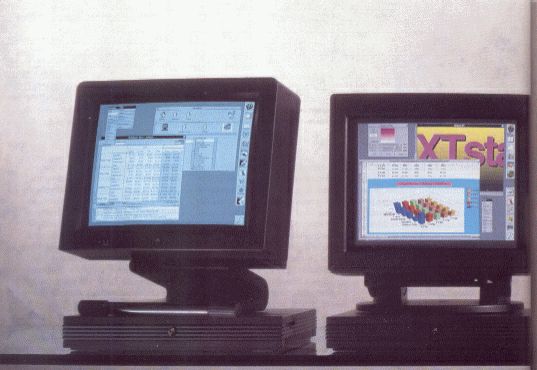|

|
Macworld Article |
|
|
|
NEXT
ON THE AGENDA |
|
Three new systems promise to
enhance Next's standing in the personal-computing arena
by Bruce F Webster
|
In
October of 1988, Steve Jobs introduced the most anticipated and
controversial computer system since the original Macintosh: the Next
system. That system, described at length in the January 1989 issue
of MacWorld, represented a new evolutionary step in personal computing.
Features introduced with that system have been showing up on the Macintosh
platform (not to mention others) ever since. Note, for instance,
Apple's "coincidental" official interest in 3-D icons,
object-oriented programming, and built-in sound digitizing. Still
Next has had a hard time selling systems due to perceived and real
limitations, such as lack of commercial software, high entry cost, and
sluggish performance. |
|

|
No one can say that
Next doesn't learn from its mistakes. At its second major rollout,
on September 18, 1990, the company introduced a line of systems that are
not only more powerful but also less expensive than the original machine.
The high-resolution grayscale display is now complemented by two color
systems. Next also got the CEOs of two of the three largest personal
computer software companies--Jim Manzi of Lotus and Alan Ashton of
WordPerfect--to introduce their products for the Next (Improv and
WordPerfect, respectively). And in an effort to quell criticism of
the machine's small installed base, Next announced that it already had
orders on the books for over 15,000 new systems.
What Was All the Hoopla About?
The Next product line now consists of three basic systems: the NeXTstation,
the NeXTstation Color, and the Nextcube. In addition, the line includes
the MegaPixel Display. the NeXT 400 dpi Laser Printer (at a reduced
price), and--the real show stoppers--the Nextdimension 32-bit
graphics/video board and the 16-inch MegaPixel Color Display.
All three of the Next systems share the following features:
-
a
25 MHz 68040 processor serving as the central processing unit (CPU),
the memory management unit (MMU), and the floating point unit (FPU)
-
A
25 MHz 56001 digital signal processor (DSP) with 24K of static RAM,
expandable to 576K
-
16
SIMM sockets for main memory, capable of accepting either 1MB or 4MB
SIMMs, with parity memory as an option
-
Next's
two VLSI "mainframe" chips, implementing eight I/O
processors (nine on the Nextcube) and other system features
-
On-board
video with separate video RAM, generating an 1120-pixels-by-832-lines
image and providing full alpha-channel support
-
Built
in Ethernet hardware with external connectors for both thin-wire (BNC
T-connector) and twisted-pair (10 Base-T) cabling, the latter able to
support Ethernet connections over standard phone wires
-
A
2.88MB 31/2-inch floppy disk drive that also reads and writes MS-DOS
disks (both 720K and 1.44MB)
-
Dual
serial (DIN-8 RS-422) ports; dedicated video and printer ports; DSP
port; and a SCSI/2 interface with both an internal and an external
port
Built-in sound input (8-bit, 8kHz sampling) and output (dual-channel
16-bit, 44.1kHz sampling)
-
Release
2.0 of the Next system software, which includes NextStep 2.0 sitting
on top of the Mach (UNIX) operating system
|
|
NeXT Page
|
